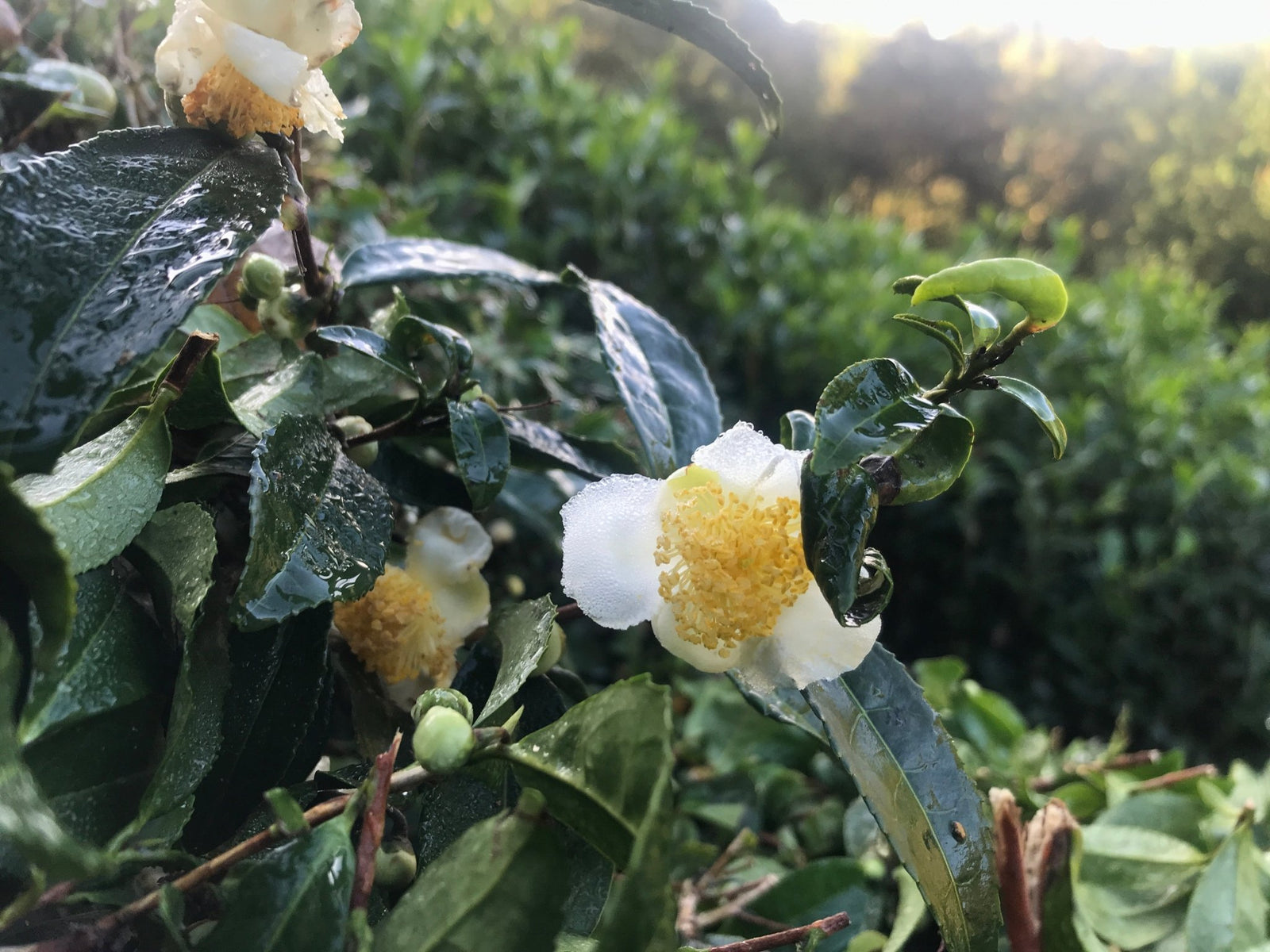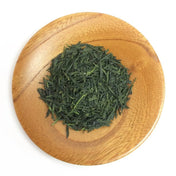Hello all!
We hope that you are enjoying your Japanese green teas along with autumnal delights like chestnuts, persimmons and pears (what are some fall delights in the area where you reside?). For some tea farmers, fall may be a time for their autumn harvest season (akibancha; 秋番茶), which tends to be lower quality tea and thus, is utilized mainly for bottled tea and green tea flavored snacks. It is also a time when one may observe the tea plant (camellia sinensis) bloom nicely with their flowers. More than tea harvesting however; in Japan, October is a beautiful and full time for rice harvesting. So, the tea farmers at Yunomi who also grow rice may be hard working out in the fields or celebrating a successful rice harvest! Our first few blog posts on the major tea producing regions in Japan focused on Kyushu and we hope that your curiosity has been sparked or that we’ve presented new information for you to digest. Personally, I have become intrigued with kamairichas and have been enjoying them as an option in the mornings. I find them to be a nice change from the familiar steamed Japanese teas.

While the Kyushu area is full of gems, it is time to transition to a different region. Today, we will be covering a new major tea region in Japan; Kyoto prefecture. Amongst the prefectures in Japan, Kyoto is fourth with respect to both tea production area and amount. Moreover, as many of you may already know, Kyoto is well known to be at the heart of Japanese tea and tea ceremony. The famous tea producing regions of Uji, Ujitawara, Wazuka, Minami-Yamashiro, and Kizu are located between two major cities, Kyoto and Nara (two ancient capitals of Japan), and around the Kizu River. Today’s post will specifically be dedicated to the very first one, Uji, as it is the oldest and probably the most respected tea producing region in Japan. However, because there is already quite a lot of accessible and relevant information on the Internet (i.e., in English!) with respect to Uji and Uj-cha, we would like to focus our post on climate change and how it is affecting the tea farmers and terroir of Uji.
View Articles on Other Regions
History of Uji-cha
Uji (宇治), as many of you may know already, is where Japanese tea originated and is probably the most famous tea producing area in Japan. History traces tea production back to the Kamakura period (1185-1333). The Zen Buddhist monk Eisai is famous for bringing tea seeds back to Kyoto from a trip to China in the late 12th century. It is said that Eisai shared Zen but also some of the tea seeds he brought back from China with Myoe Shounin (Shounin signifies high priest status) of Kozanji Temple. Myoe is therefore credited for cultivating the very first tea bushes in Kyoto, in a place called Toganoo Fukase where the temple was located. These were some of the initial steps taken by Myoe to spread the pleasures of tea drinking throughout Japan. Perhaps, he recognized the ideal growing conditions of Uji when he selected it to be the place to transplant the tea bushes (once the seedlings were ready to be transplanted) and cultivate tea at a larger scale.
Due to the good soil quality and topography of Uji, amongst other optimal conditions for tea, it did not take too long for tea cultivation to expand. The custom of tea drinking as a pass time and as an art form began to spread during the mid-1400s. Indeed, Uji-cha came to be considered a first-class gift, and even a type of tea gambling game called “Tocha” became popular amongst the intellectual and upper classes in this time. The game consisted in participants attempting to guess if a matcha served to them was a “Honcha” (literally, “real tea”) grown in the Uji area, or a “Hicha”, tea grown in some other less well renowned region (Note: Tocha still continues today; however, it is commonly done with gyokuro and sencha instead of matcha). The combination of tea drinking and cuisine subsequently followed. By the end of the 16th century, “Cha no Yu”, the Japanese tea ceremony which celebrates the beauty of tea ceremony tools and sitting room ornamentation was developed. Sen-no-Rikyu, considered to be the greatest tea scholar in Japan, not only helped spread the tea ceremony and the region’s fame, he also played a critical role in introducing the spirit of “wabi-sabi” into the Japanese tea ceremony. Quickly following the development of the Uji shading method and steaming, the Uji region also became famous for producing extremely high quality matcha and gyokuro and the legend continues to this present day.

Uji-cha, Today
Uji-cha is considered to be one of the top three major teas of Japan (Uji-cha, Shizuoka-cha, and Sayama-cha). Perhaps, before specifically starting to focus on the topic of climate change, it may be important to specify what is defined as “Uji-cha” or Uji tea today. Uji-cha actually does not refer to tea products exclusively cultivated inside the Uji area. This is because in the year 2006, the Ujicha Cooperative (Kyoto Prefecture Tea Cooperative) made a decision to define Uji-cha as teas which are: 1) grown in Kyoto, Nara, Shiga and Mie prefectures (4 neighboring prefectures) 2) processed inside Kyoto prefecture 3) using the specific techniques derived from the Uji Area. While this movement has helped to sustain the Uji-cha label and has helped meet the demands for Uji-cha from consumers, it also means that the majority of the tea leaves sold as “Uji-cha” are actually not grown inside the Uji area. In fact, in 2019, data from the Kyoto Prefecture website indicated there were only 112 active tea growers and 21 registered tea plantations inside Uji. Unfortunately, numbers continue to decrease due to factors such as the ongoing urbanization of rural areas (especially considering Uji is in between two major cities of Kyoto and Nara) and the aging population. True single origin tea from Uji is actually quite rare! But, there are still many high quality tea farmers and teas to spotlight at Yunomi in the neighboring regions.
Uji-cha and Climate Change
So, how is climate change impacting the tea farmers and cultivation methods in Uji? Essentially, it is threatening both the unique and historic terroir of Uji as well as the utility of tea farmers’ knowledge that has been passed down through generations. Some of the major challenges that affect how tea bushes grow and the quality of tea produced include:
- Sudden temperature drops in spring
- Overall higher temperatures in summer and fall
- Changes in precipitation quantity and duration
- Longer periods of drought
- Reduced morning fog (fog is important for tea!)
In sum, all of these changes can negatively impact the quality and yield of tea. Fortunately, according to recent research, tea farmers are learning to adapt with the changes in their natural environment (Ashardiono, 2019). It is important to note that the tea farmers in Uji have sensed the changing climatic conditions on their tea plantations for decades, but that they also possess valuable information with respect to changes in the environment which has been passed down through their ancestors. Accordingly, the tea farmers have been conscious of these ongoing changes and live side to side with these extreme climatic fluctuations. Moreover, in order to continue producing high quality tea, they are using their knowledge of how terroir elements interact. Some are experimenting with traditional practices in order to respond to the challenges of weather extremes and altered patterns associated with climate change and to retain the unique terroir of their tea. While the rate of environmental change is unprecedented, farmers are finding some success by experimenting with the same traditional methods they’ve always used.
For instance, currently in Uji, tea farmers have responded by altering the amount of straw or leaf covering that they use to shade teas. This helps compensate for the higher temperatures and reduced morning fog. Irrigation is not traditionally used but it may prove necessary to prevent excessive stress in drought years. Organic farming methods and the application of straw and other organic material to the soil may help increase the soil’s resilience to flooding and water holding capacity to help the plants withstand drought. Tea farmers not specific to the Uji region have also been experimenting with agroforestry. That is, tea can be grown in a forest-like ecosystem with trees and shrubs to make shade and favorable micro-climates. This is perhaps why mountain grown teas may be well positioned for climate change resilience. In certain agroforestry arrangements, the amount of moisture tea plants lose is minimized and the tea bushes are also naturally protected from frost.
Because climate change also impacts the timing of the seasons, the timing and number of harvests may need to be modified in order to match variable growth. As a simple example, in Japan, the ichibancha is often harvested on the 88th night (which falls on May 1st or 2nd, depending on the year). However, with climate change, tea farmers may need to start to initiate earlier harvests. Finally, integrating new cultivars on a rotational basis could be considered as a long-term adaptation method. While this may not seem desirable, many tea farmers have for years developed their own cultivars (although these cultivars are sometimes only used to produce tea for tea competitions and not sold commercially), adapted to their specific farm conditions. In order to continue to dance well with climate change, experimenting with innovative agricultural and socioeconomic strategies are warranted. Tea farmers should therefore be encouraged to be creative, to develop new cultivars, and to offer opportunities for subsequent generations.
Notwithstanding the resilience of the tea farmers, scientists could also play a valuable role in helping the tea farmers adapt by supplying high quality and precise weather data along with analytics of tea production. This knowledge could help the farmers understand how previous conditions affect the quality of their tea as well as to help them anticipate and mitigate future weather events. Government research agencies could also help experiment with production practices and develop new cultivars. Valuing the unique traditional knowledge of tea farmers, and the challenge to respond to climate change while maintaining the high quality and unique terroir associated with Uji-cha, should be reflected in the rest of society's willingness to support Uji tea farmers.
Into the Future of Tea and Climate Change

When one drinks a cup of tea, one is drinking a beverage that is rooted in a particular time, context and space. Tea plants are known for being very sensitive to the environments in which they are grown. Perhaps, that is one of the reasons why tea farmers can become so passionate about growing their own special regional teas, especially with knowledge passed down through generations. Perhaps the interplay of terroir and traditional knowledge is also why tea connoisseurs enjoy discerning the distinct and unique tea characteristics of, say, a gyokuro from Uji in comparison to a gyokuro from Yame. Unfortunately, this sensitivity makes the camellia sinensis vulnerable to the impacts of climate change. Although our post focused on Uji and Uji tea farmers, it is important to recognize the compound effects climate change has on tea farmers and tea production all throughout Japan and world wide (and of course, as many of you are aware, it extends beyond tea!). In fact, it is highly likely that the tea you are drinking has been affected to some degree by climate change, and maybe the tea farmer even had to modify their parents’ practices in order to adapt to climate change. So the next time you sit down to enjoy a good quality tea from Uji, perhaps you can extend your gratitude to the tea farmer(s) who are learning how to dance gracefully with climate change, and be inspired to make your own changes to slow climate change and make the tea farmers’ jobs a little easier!
Stay tuned as we will be spotlighting tea farmers from around the Uji region in our subsequent posts...
References
Ashardiono, F. (2019). on Traditional Tea Cultivation in Uji Area. Sustainable Solutions for Food Security: Combating Climate Change by Adaptation, 311.
Kinoshita, A. (2014, February 1). Sen no Rikyu - The Greatest Tea Master. The Kyoto Project. http://thekyotoproject.org/english/sen-no-rikyu-the-greatest-tea-master/
Banner image credit: Moé Kishida; camellia seninsis blooming in Wazuka, Japan.


